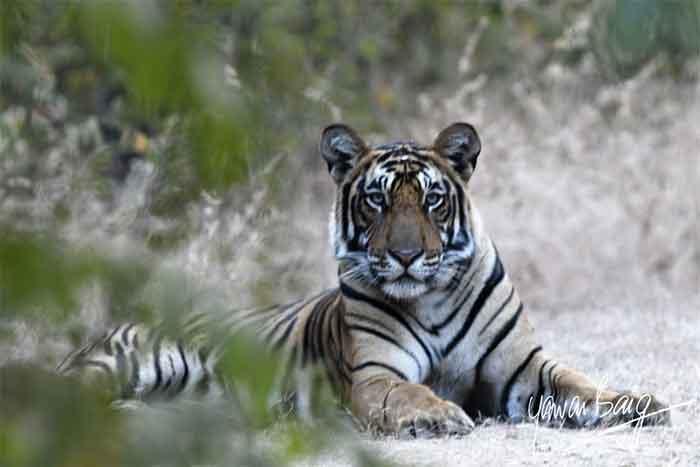Tigers and leopards are among the 10 apex predators most threatened by the world’s roads.
Jeffrey Dunnink
26 May 2022

Image Courtesy: Countercurrents
Designed for speed and efficiency, roadways across the globe are effectively killing wildlife whose futures are intrinsically linked to the future of the planet: apex predators, those species including big cats like tigers and leopards that sit at the top of the food chain and ensure the health of all biodiversity.
A new study I co-authored confirms that apex predators in Asia currently face the greatest threat from roads, likely due to the region’s high road density and the numerous apex predators found there. Eight out of the 10 species most impacted by roads were found in Asia, with the sloth bear, tiger, dhole, Asiatic black bear and clouded leopard leading the list.
The outlook for the next 30 years is even more dire. More than 90% of the 25 million kilometres of new global road construction expected between now and 2050 will be built in developing nations that host critical ecosystems and rich biodiversity areas. Proposed road developments across Africa, the Brazilian Amazon and Nepal are expected to intersect roughly 500 protected areas. This development directly threatens the core habitats of apex predators found in these regions and will potentially disrupt the functioning and stability of their ecosystems. This is particularly concerning where road developments will impact areas of rich biodiversity and where conservation gains have been so painstakingly achieved.
Ironically, as we celebrate the Year of the Tiger this year, road construction in Nepal is expected to bisect tiger strongholds, threatening to reverse the remarkable and previously inconceivable progress made to conserve the world’s remaining 4,500 wild tigers from extinction. In the Brazilian Amazon, 36,500 km of future roads will be built or upgraded inside the home ranges of pumas, ocelots and jaguars.
Naturally, the African Union’s development corridors are designed to promote development and drive investment in previously ignored areas. While marginalised communities must be given access to lifesaving development infrastructure and investment, this goal can be achieved while also conserving the continent’s fragile ecosystems and at-risk apex predator populations. As it now stands, the development planned in Tanzania’s Serengeti National Park, in particular, is expected to devastate one of the world’s greatest animal migrations, causing a domino effect on healthy apex predator populations.
It’s important to remember that roads don’t just kill the animals trying to cross them; they divide habitat patches into increasingly smaller fragments. Apex predators are disproportionately impacted by discontinuous habitats due to their need to roam large undisturbed areas. Research has found that predators such as the jaguar will completely avoid all roads in their habitat, often isolating individuals from the rest of their population. The ubiquity of roads also presents a barrier for mating between jaguars. This ultimately reduces the genetic diversity and strength of the population and is a particular threat to apex predators due to their large home range and small population sizes.
Another unintended consequence of rampant road development is increased poaching. Roads facilitate easy access to previously wild areas, allowing for the expansion of permanent human settlement. More roads make it easier for poachers to reach remote wildlife populations and facilitate the transport of illegal wildlife products across a greater area. Indeed, snares for wildlife and poachers are often found at higher rates close to roads and human settlements.
Despite these grim consequences, there is a way to achieve human development objectives while allowing predators to thrive. When road projects are deemed vital to the development of an area and the surrounding communities, they must be built with wildlife in mind—intentionally located well outside of protected areas and predator strongholds.
Wildlife crossing structures, such as tunnels and underpasses, need to be integrated into road planning and budgetary decisions from the get-go. It is only through inclusive planning processes, where the voices of local communities, conservation scientists, road engineers and government officials are all equally weighted, that sustainable road development can be achieved.
Costa Rica offers an excellent example of this type of collaboration. Although often considered the gold standard in conservation, Costa Rica hosts the highest density of roads in Central America, with one stretch of the Limón-Moín Route 257 responsible for 4.6 wildlife roadkills per hour, primarily due to speeding. By monitoring the highways for all roadkills, conservation scientists have identified key wildlife crossing areas and informed the construction of structures to ensure their safe passage, from arboreal crossings for tree-dwelling species to underpasses for the flat-footed ones. Critically, scientists have formed a strong partnership with local and national governments who fully support the concept of “wildlife-friendly roads.”
Our futures and health are forever intertwined with those of non-human animals, and people also benefit from wildlife-friendly roads. The recolonisation of pumas in North Dakota is estimated to have reduced costs of deer-vehicle collisions by more than $1 billion, and scientists estimate a recolonisation of the Eastern United States by pumas could reduce deer-vehicle collisions by 22% over 30 years, averting 21,400 human injuries and 155 human fatalities, and saving more than $2 billion in costs.
From wildlife-vehicle collisions to unintentionally creating new pathways for poachers to target our planet’s most cherished wildlife, roads pose a major threat to apex predators.
With research confirming that this threat will only intensify over the next 30 years, there is now a small window of opportunity to ensure that these developments do not unduly impact our natural world.
By planning roads more carefully, avoiding their construction in protected areas and adopting mitigation measures like wildlife crossings, we can protect apex predators and the critical role they play in the health and survival of our planet.
Jeffrey Dunnink is the Furs for Life coordinator at Panthera, a global wild cat conservation organisation.
Source: Independent Media Institute
Credit Line: This article was produced by Earth | Food | Life, a project of the Independent Media Institute.
No comments:
Post a Comment